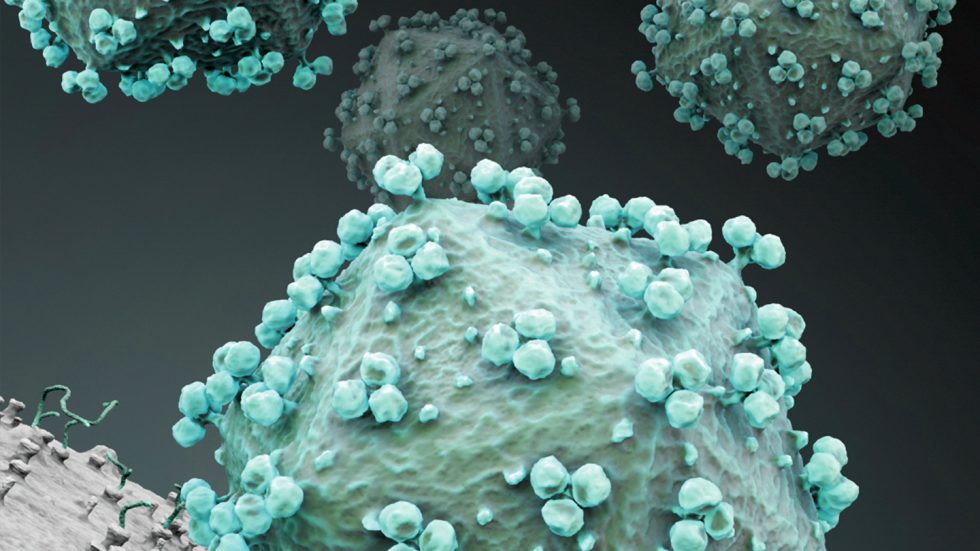How Women Came to Kenyon
Kenyon's first females graduated forty years ago. To mark the occasion, the Bulletin recalls how coeducation came…
Read The Story
In the 2013 film World War Z, a viral infection prevents a zombie attack. Is this just science fiction, or is there some real science behind it? To shed some light on the question, we turned to Joan Slonczewski, an expert on microbes as well as an acclaimed science fiction writer. Her answer bypasses zombies but does involve a truly scary virus.
The virus that causes AIDS has in fact been modified to cure genetic disease. Human immunodeficiency virus (HIV) is converted to a “vector,” a modified virus that carries a valuable gene into a human chromosome. HIV-derived vectors have “cured” a girl suffering terminal leukemia, by reprogramming her immune cells to kill cancer cells. Another HIV-derived vector halted the brain deterioration suffered by two young boys with adrenoleukodystrophy (ALD), an incurable condition caused by a defective gene for a transport protein needed by brain cells.
Previously, the best-known virus protecting our health was cowpox virus (vaccinia) to prevent smallpox. Vaccinia virus stimulates the human immune system to prevent infection by the closely related smallpox virus. Vaccinia inoculation formed the basis of the first “vaccine” against a deadly human virus.
Today, we engineer viruses for gene therapy. Gene therapy involves replacing a defective gene in our body cells to eliminate the effects of an inherited gene defect. The replacement requires a vector to carry the replacement gene into a human chromosome. Surprisingly, our most effective—and safest—vectors are made from HIV. What makes HIV-derived vectors (called “lentivectors”) so promising is precisely the property that makes “wild-type” HIV so deadly: its ability to integrate its genome (its entire genetic information) into a human chromosome and stay there, replicating indefinitely within the host cell. For reasons we don’t understand, the integration of HIV is more stable than for other kinds of virus, without disrupting cell function or causing cancer. This is what makes the lentivector such a valuable tool.
If the vector is made from HIV, how do we keep it from causing AIDS? First, the lentivector is heavily engineered in the test tube. All of its disease-causing genes are cut out, leaving only the critical ends required for host integration. This is called a “gutted vector.” In the gutted middle, we then place the key genes needed to help the host. For the girl with leukemia, this gene encoded a protein directing her T-cells to kill the cancer cells. For the boys with ALD, the gene replaced their defective enzyme. In both cases, the cells to be infected were first removed from the body, then vector infection was performed in tissue culture. Once the gene integration was safely confirmed, the treated cells were returned to the host.
If you remove all the HIV disease genes, how can the lentivector still infect the cell to insert its genome? You have to put key disease genes on “helper plasmids” that briefly express the infection genes, then disappear. And you add viral control genes to control the vector gene replacement in the host. These control genes come from other viruses like respiratory syncytial virus and (no kidding) woodchuck hepatitis virus. It sounds like Frankenstein, but these Franken-viruses save lives.
For the wild-type HIV, we now know how to wipe out AIDS by testing and treatment. We discovered this from the President’s Emergency Plan for AIDS Relief, begun by President Bush to fight AIDS in Africa and continued by President Obama. The Centers for Disease Control now recommends testing all of us for HIV. In my science fiction novel The Highest Frontier, set a hundred years in the future, HIV is called “Human Improvement Vector” because it saved more lives than it ever killed. By committing our tax dollars for AIDS prevention and lentivector research, we can make this dream a reality.
Kenyon's first females graduated forty years ago. To mark the occasion, the Bulletin recalls how coeducation came…
Read The StoryBiochemist and Beatles aficionado, Kenyon's new president grew up with the lessons of learning.
Read The StoryAn immensely complex transplant operation gives a soldier two new limbs. On the team that made it happen: a husband…
Read The StoryDiscovering Danville's famous raccoon dinner, a Kenyon student muses on socio-culinary boundaries and the people…
Read The Story